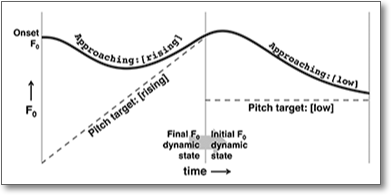
Understand PENTA framework
Proposed in Xu (2005), Parallel Encoding and Target Approximation (PENTA) framework is based on the recognition of two basic facts: that speech conveys communicative meanings, and that it is produced by an articulatory system.
In PENTA, a communicative function represents a relation between the intended communicative meaning and the physical implementation of the speech prosody. Different communicative function may span across different temporal intervals and they must have different encoding schemes. For example, lexical tones require a syllable for each transmission while lexical focus may require at least two temporal regions consisting of one or more syllables to create a contrastive focus. With the different encoding schemes, communicative functions are transmitted in parallel in the sense that they each add to the specification of the target and/or the target approximation process in a
unique way. The combined effects are then implemented through the target approximation process, resulting in the dynamic changes in surface F0 values and their timings.
The detail implementation of the PENTA framework in PENTAtrainer2 can be found in Xu and Prom-on (submitted)

Theoretical details of target approximation can be found in Xu and Wang (2001), and the details of its quantitative implementation can be found in Prom-on et al. (2009).

